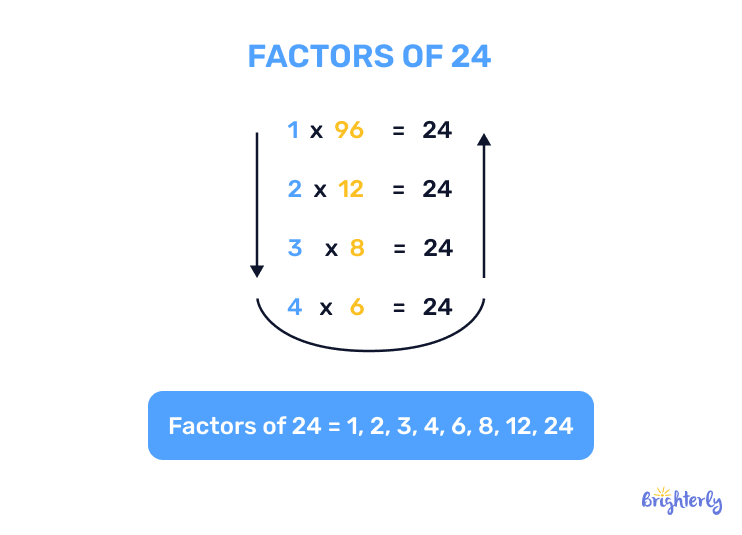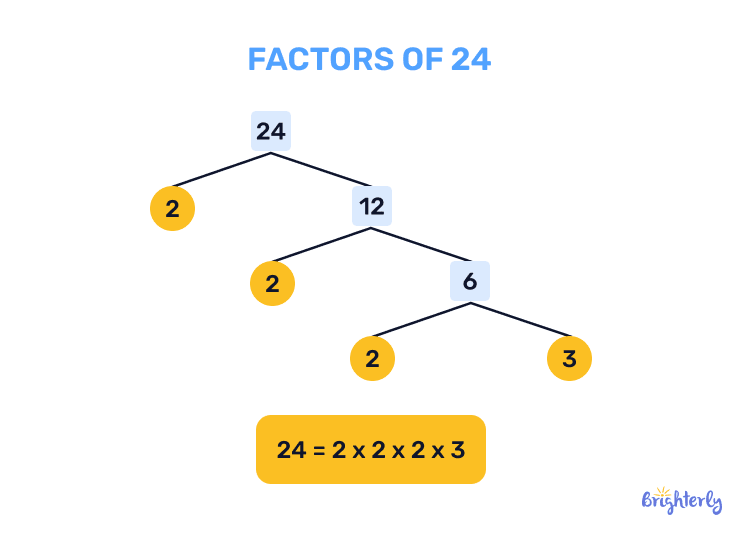Factors of 24 – Definition With Examples
Updated on December 1, 2025
Understanding factors is a key foundational skill in math that will pave the way for you to learn how to carry out complex operations in multiplication, division, and more. That’s why it helps to learn the factors of numbers, their properties, and their importance in the world of math.
Here, we’re dedicated to helping you work with factors, so today we’re going to look at the factors of the number 24. In this article, we’re going to cover all the factors of 24, its factor pairs, and the difference between its composite and prime factors. Then, we’ll share some practice problems for you so you can test out the knowledge you’ve gained from this article.
Now, let’s get stuck into the factor of 24!
What are the factors of 24?
The factors of 24 are whole numbers (also known as integers) that, when multiplied, yield 24. This also means that these numbers can be used to divide the number 24 with no remainder. So, what are all the factors of 24? They are as follows:
- 1
- 2
- 3
- 4
- 6
- 8
- 12
- 24

Properties of factors of 24
The factors for 24 each have their own fascinating properties that make the numbers unique or special:
- 1 is the multiplicative identity, which means that when it is multiplied by any number, the result is always that number
- 2 is the smallest prime number and the smallest even number
- 3 is a prime number and is also the second triangular number, which means it can be formed by adding consecutive numbers (1 + 2)
- 4 is the square number, which means it is the result of squaring a number (22)
- 6 is the smallest perfect number, which means it is the sum of its factors (1 + 2 + 3)
- 8 is the smallest cube number after 1, which means it is the result of cubing a number (23)
- 12 is divisible by its digits (1 and 2), making it a Harshad number
- 24 is also a Harshad number
Factors of 24 in pairs
In order for a number to be a factor of another number, it needs to be part of a factor pair. Factor pairs are two numbers that multiply together to result in our given number. The factor pairs of 24 are:
- 1 and 24
- 2 and 12
- 3 and 8
- 4 and 6
Difference between composite and prime factors of 24
The number 24 has both composite and prime factors. These factors differ depending on whether they have factors of their own. Composite factors have many factors themselves, whereas the only factors of prime factors are one and themselves.
The composite factors of 24 are:
- 4
- 6
- 8
- 12
- 24
The prime factors of 24, meanwhile, are:
- 2
- 3
Calculating factors of 24
To calculate the factors for 24, divide 24 by the numbers preceding it to see if you can divide it without a remainder. It can be helpful to start at 1 and make your way up. You won’t need to go beyond 12, because the only remaining factor after half of your number is your number.
It’s also worth looking at divisibility rules to find all your factors. For example, because 24 ends in an even digit, we know it is divisible by 2. Similarly, as its digits add up to a multiple of 3, we know it will also be a factor of 3. This can help you narrow down potential factors.
Writing factor pairs of 24
We’ve explored the factor pairs of 24 above, but did you know there is a certain way you should be writing them? When writing factor pairs, you should put your numbers between two parentheses. Then, your smaller number comes first, followed by a comma, and then your largest number. We would write the factor pairs of 24 as such:
- (1, 24)
- (2, 12)
- (3, 8)
- (4, 6)
Practice problems on factors of 24
Here, we’ve covered everything you need to know about factors and the factors of 24. Now, it’s time for you to use that newfound knowledge and answer some practice problems. These questions will help you test your new expertise and learn how to solve problems involving the factors of 24. You can use a pen and paper to write down your answers, show your working, and explain your reasoning.
- List all the factors of 24 and all factor pairs.
- What are the prime factors of 24? How do you know they are prime factors and not composite factors?
- What is the prime factorization of 24?
Conclusion
In this article, we’ve taken you through all the 24 factors, as well as their factor pairs and their prime and composite factors. We’ve answered key questions, including “What are the factors for 24?” and “What number multiply to 24?” We’ve also provided you with some practice problems to familiarize you with answering questions about the factors of 24.
Now you can go forth equipped with this vital knowledge and work more easily on finding the factors of other numbers. Factors help you to improve key skills like number sense, and they can also help you with operations like multiplication and division. Plus, they strengthen your understanding of concepts like multiples and times tables.
How will you apply your newly acquired knowledge?
Frequently asked questions on factors of 24
What are factors of 24?
Factors of 24 are integers (aka whole numbers) that are divisible by 24 with no remainders. This means they can also be multiplied by other whole numbers to give 24. All factors of 24 are:
- 1
- 2
- 3
- 4
- 6
- 8
- 12
What are the factor pairs of 24?
The factor pairs for 24 are two whole numbers, also known as integers, that can be multiplied together to give us 24. The factor pairs of 24 are:
- 1 x 24 or (1, 24)
- 2 x 12 or (2, 12)
- 3 x 8 or (3, 8)
- 4 x 6 or (4, 6)
What is the prime factorization of 24?
The prime factorization of 24 is 2 x 2 x 2 x 3 (or 23 x 3). You work this out by dividing 24 by its smallest prime factor until you can no longer, then moving to the next smallest prime factor, until you can no longer divide.

Is 24 prime or composite?
24 is a composite number. This means it has factors other than 1 and itself. A prime number, meanwhile, only has 2 factors: itself and 1. We can see here that 24 has multiple factors, making it a composite number.
What are prime and composite factors of 24?
The prime factors of 24 are numbers that have only 1 and themselves as factors. The prime factors of 24 are:
- 2
- 3
The composite factors of 24 are numbers that have multiple factors beyond 1 and themselves. They are:
- 4
- 6
- 8
- 12
- 24







